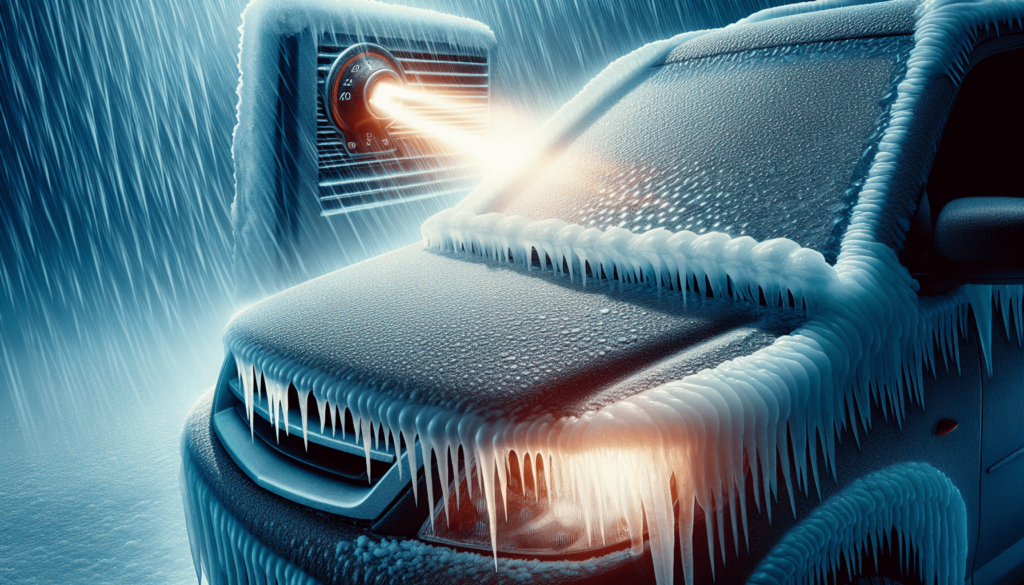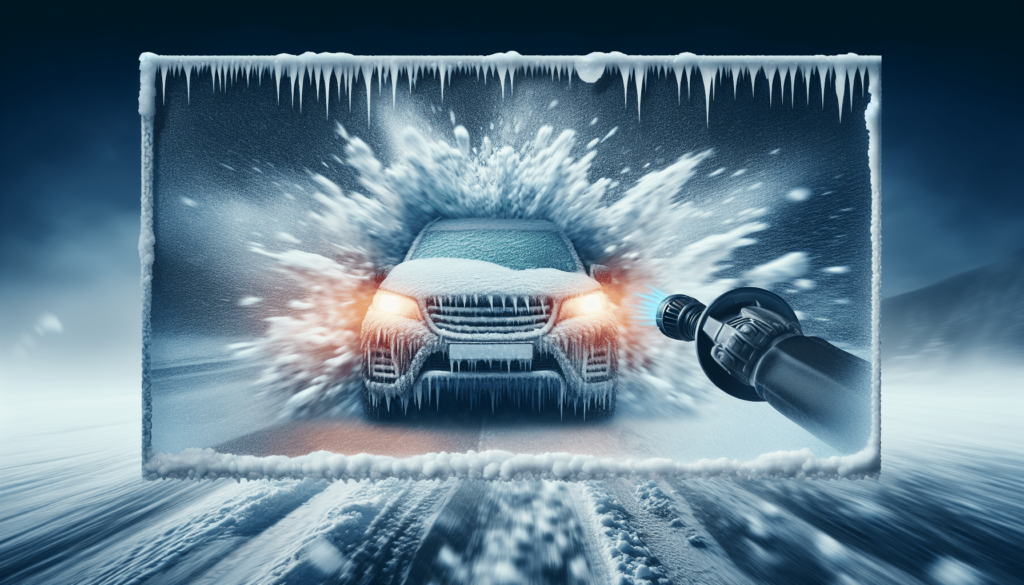Getting your vehicle ready for extreme weather conditions is essential to ensure your safety and the longevity of your car. From scorching summers to bone-chilling winters, your vehicle needs special attention to withstand these harsh environments. Whether it’s protecting your car’s paint against the blazing sun or ensuring your tires have enough traction to navigate icy roads, this article will provide you with valuable tips and tricks to prepare your vehicle and have a worry-free drive, no matter what the weather throws your way.

Check Your Tires
Inspect Tread Depth
One of the most important things to do when preparing your vehicle for extreme weather conditions is to check your tires. Start by inspecting the tread depth of your tires. Tread depth is crucial for providing traction on slippery roads. You can check the tread depth by using a tread depth gauge or the penny test. If the tread depth is less than 2/32 of an inch, it’s time to replace your tires as they will not be able to grip the road properly.
Check Tire Pressure
In addition to inspecting the tread depth, it’s essential to check the tire pressure as well. Extreme weather conditions can cause tire pressure to fluctuate, so it’s crucial to ensure that your tires are properly inflated. Underinflated tires can affect your vehicle’s handling and fuel efficiency, while overinflated tires can reduce traction and cause uneven wear. Refer to the recommended tire pressure in your vehicle’s manual or the sticker on the driver’s side door jamb and use a tire pressure gauge to check and adjust the pressure if needed.
Consider Snow Tires
To further enhance your vehicle’s performance in extreme weather conditions, you might want to consider investing in snow tires. Snow tires are specifically designed to provide better traction on snowy and icy roads. They have a unique tread pattern and rubber compound that allows for improved grip and braking. If you live in an area with heavy snowfall or regularly encounter icy roads, snow tires can greatly enhance your safety and confidence while driving.
Inspect Your Battery
Check Battery Age
Extreme weather conditions can take a toll on your vehicle’s battery. It’s essential to check the battery’s age to ensure that it can handle the demands of winter. Most car batteries last around 3-5 years, so if your battery is approaching this age range, consider getting it tested or replaced to prevent unexpected breakdowns during extreme cold weather.
Clean Battery Terminals
Another important step in preparing your vehicle for extreme weather conditions is to clean the battery terminals. Over time, corrosion can build up on the battery terminals, affecting their ability to conduct electricity efficiently. Use a battery terminal brush or a mixture of baking soda and water to gently clean the terminals. Make sure to disconnect the negative terminal before cleaning and reconnect it securely after cleaning.
Test Battery Voltage
To ensure that your battery is in good condition, consider testing its voltage. You can use a digital multimeter to measure the battery voltage. A fully charged battery should have a voltage reading between 12.4 and 12.6 volts. If the voltage is significantly lower, it might indicate a weak battery that needs to be replaced. It’s better to address any battery issues before extreme weather conditions hit to avoid getting stranded with a dead battery.
Evaluate Your Coolant
Check Coolant Level
Proper coolant levels are crucial in extreme weather conditions to prevent your engine from freezing or overheating. Before winter arrives, check the coolant level in your vehicle. The coolant reservoir typically has a minimum and maximum level indicator. Make sure the coolant level is between these markers. If it’s low, top it up with the recommended coolant type specified in your vehicle’s manual.
Inspect Coolant Hoses
In addition to checking the coolant level, inspect the coolant hoses for any signs of wear, cracks, or leaks. Extreme temperature changes can cause the hoses to become brittle and prone to failure. Gently squeeze the hoses to check for flexibility, and if you notice any cracks or leaks, it’s best to replace them. Operating with damaged hoses can lead to coolant leaks, overheating, and engine damage.
Consider Using Antifreeze
To protect your engine from freezing in extreme cold temperatures, consider using antifreeze. Antifreeze, also known as coolant, not only prevents freezing but also helps regulate engine temperature and prevent corrosion. It’s important to use the right type of antifreeze recommended for your vehicle and ensure that the antifreeze-to-water ratio is optimal for the prevailing weather conditions. Consult your vehicle’s manual or a professional mechanic for guidance on the appropriate antifreeze for your vehicle.
Check Your Wiper Blades
Inspect Blade Condition
Clear visibility is essential for safe driving, especially during extreme weather conditions. Inspect the condition of your wiper blades and look for any signs of wear, such as cracks or tears. Damaged wiper blades can leave streaks on your windshield, compromising your visibility. If your wiper blades are no longer in optimal condition, it’s time to replace them.
Replace if Necessary
If your wiper blades show signs of wear or do not effectively clear your windshield, replace them immediately. It’s recommended to replace wiper blades every six months to a year, depending on usage and weather conditions. Consider investing in high-quality, all-season wiper blades that are designed to withstand extreme weather conditions. These blades often have features like a reinforced rubber shell or a special coating to prevent ice and snow buildup.
Consider Winter Blades
For even better performance in extreme winter weather, consider using winter wiper blades. Winter blades are specially designed with a rubber boot that prevents ice and snow from clogging the blades’ pivots and freezing the rubber. They also feature a stronger construction that allows them to handle heavy snow and ice without the risk of bending or breaking. Winter blades can provide superior visibility and smoother operation in harsh winter conditions.

Test Your Lights
Check Headlights
Properly functioning headlights are crucial for safe driving, especially in low-visibility conditions often associated with extreme weather. Before winter arrives, check that all your headlights are working correctly. Turn on your headlights and ensure that both the high beam and low beam settings are functioning. Replace any burnt-out bulbs and ensure that the headlight lenses are clean and free of debris or fogging.
Test Brake Lights
Your brake lights play a crucial role in communicating your intentions to other drivers, especially in poor weather conditions. A simple way to test your brake lights is to work with a partner or use a reflective surface to check if the lights illuminate when you apply the brakes. If any of the brake lights are not working, replace the bulbs as soon as possible.
Ensure Proper Functioning
In addition to the headlights and brake lights, ensure that all other lights on your vehicle are in proper working order. This includes turn signals, hazard lights, fog lights, and interior lights. Remember to clean the light covers regularly to remove dirt and grime that can reduce visibility. By ensuring all your lights are functioning correctly, you enhance both your own safety and that of other drivers on the road.
Examine Your Belts and Hoses
Inspect for Cracks or Damage
Belts and hoses play a vital role in the proper functioning of your vehicle’s engine and other systems. Extreme weather conditions, with their temperature extremes, can cause belts and hoses to become brittle or develop cracks. Inspect all belts for signs of wear, such as fraying or cracking. Examine hoses for leaks, bulges, or other signs of damage. If you notice any issues, it’s important to replace the affected belts or hoses promptly to prevent potential failures.
Check for Proper Tension
Belts need to have proper tension to work efficiently. Use a belt tension gauge or refer to your vehicle’s manual to ensure that the belts are properly tensioned. Loose or overtightened belts can lead to inadequate power transfer, excessive wear, or even belt failure. If you are unsure about the proper tension, consult a professional mechanic for assistance.
Replace if Necessary
If you find any belts or hoses that are damaged, cracked, or worn, it’s essential to replace them promptly. Driving with worn or damaged belts can lead to sudden failures, leaving you stranded on the side of the road. Additionally, if a hose develops a leak, it can cause coolant or other fluids to spill, leading to engine overheating or other serious issues. Regularly inspecting and replacing belts and hoses as needed will help ensure the reliability and longevity of your vehicle.
Prepare Winter Emergency Kit
Include Blankets and Warm Clothing
When extreme weather conditions hit, it’s important to be prepared for emergencies. One crucial aspect is having a well-stocked winter emergency kit in your vehicle. Include items such as blankets and warm clothing to keep you and your passengers warm in case of a breakdown or getting stuck in the snow. Having extra layers of clothing and blankets can make a significant difference in maintaining body heat and preventing hypothermia.
Pack Non-Perishable Food and Water
In addition to warmth, it’s essential to have an emergency food and water supply. Pack non-perishable food items like energy bars, granola bars, or canned goods that can provide sustenance in case you are stranded for an extended period. Include a supply of bottled water to keep you hydrated. Remember to check and rotate these items periodically to ensure they are fresh and have not expired.
Add Emergency Tools and Supplies
Your winter emergency kit should also include essential tools and supplies. Some items to consider are a flashlight with spare batteries, a shovel for digging out of snow, an ice scraper, jumper cables, a tire inflator or portable air compressor, and a basic toolkit. Additionally, carry items like a first aid kit, emergency flares or reflective triangles, and a portable phone charger. These tools and supplies can be extremely useful in various emergency situations.
Check Your HVAC System
Inspect Heating System
During extreme weather conditions, having a properly functioning heating system is crucial for your comfort and safety. Before winter arrives, inspect your vehicle’s heating system. Turn on the heat and ensure that it’s blowing warm air and that the airflow is sufficient. If you notice any issues, such as weak or inconsistent heat, strange smells, or unusual noises, have your heating system checked by a professional.
Test Defrosting Function
A functional defrosting system is essential to keep your windshield clear and ensure optimal visibility in extreme weather conditions. Test the defrosting function by turning it on and checking if the airflow sufficiently clears the windshield and side windows. If the defrosting system is not working efficiently, have it inspected and repaired to prevent impaired visibility during winter driving.
Top up Windshield Washer Fluid
Clear visibility is critical for safe driving, especially during winter when roads are often covered in snow, slush, and salt. Make sure your windshield washer fluid reservoir is topped up with a winter-specific windshield washer fluid. Winter solutions are formulated to prevent freezing on your windshield and effectively remove dirt and grime. Regularly check the fluid level throughout the winter and refill as needed.
Protect Your Vehicle’s Exterior
Regularly Wash and Wax
Winter weather can be tough on your vehicle’s exterior, with snow, ice, and road salt causing potential damage and corrosion. Regularly washing your vehicle is an effective way to remove these harmful substances and help maintain its appearance. Use a car wash soap that is specifically designed for winter use and pay special attention to the undercarriage to remove salt and road debris. After washing, apply a layer of wax to protect the paint from harsh elements and make it easier to remove snow and ice.
Apply Sealant or Protective Film
For an extra layer of protection, consider applying a sealant or protective film to your vehicle’s exterior. These products create a barrier against dirt, salt, and chemicals, helping to prevent rust and corrosion. The sealant or protective film can be applied to areas prone to damage, such as the lower body panels and behind the wheels. Follow the manufacturer’s instructions for application and reapplication intervals.
Cover with a Weatherproof Car Cover
If you have limited garage space or your vehicle will be parked for an extended period, consider using a weatherproof car cover to protect it from the elements. A car cover can help shield your vehicle from snow, ice, and UV rays that can fade the paint and damage the interior. Ensure that the car cover is specifically designed for your vehicle’s make and model and provides proper ventilation to prevent moisture buildup.
Consider Special Accessories
Install Winter Tire Chains
In extreme winter weather conditions where roads are covered in deep snow or ice, winter tire chains can provide additional traction and improve your vehicle’s handling. Tire chains are installed over your existing tires and provide better grip on slippery surfaces. Make sure to choose tire chains that are approved for your vehicle and consult your vehicle’s manual for instructions on proper installation and usage.
Add Snow Brushes and Ice Scrapers
Removing snow and ice from your vehicle’s windows, roof, and body is essential for safe driving and preventing accidents caused by impaired visibility. Invest in snow brushes and ice scrapers that are sturdy and effective in clearing snow and ice without scratching your vehicle’s surfaces. Additionally, consider purchasing a snow broom with an extendable handle to easily reach and clear snow from the roof of your vehicle.
Consider All-Weather Floor Mats
Protecting your vehicle’s interior from wet, muddy, or snowy boots and shoes is essential during extreme weather conditions. Consider investing in all-weather floor mats that are designed to trap and contain dirt, water, and snow. All-weather floor mats are easy to clean and can help preserve your vehicle’s carpeting from stains and damage. Opt for custom-fit mats for better coverage and a cleaner look.
By following these comprehensive steps to prepare your vehicle for extreme weather conditions, you can ensure your safety and peace of mind while driving in challenging winter conditions. Remember, prevention is better than cure, so it’s essential to address any issues or perform maintenance tasks before the cold weather arrives. Stay safe and enjoy your winter driving experience!

